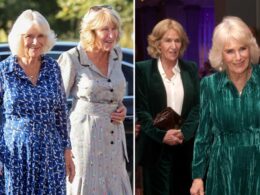When Freddie Mercury was looking to break free of Queen as his band went on hiatus in 1983, he turned to a King — King of Pop, Michael Jackson.
The two late music legends were mutual fans — Jackson even suggested that Queen release “Another One Bites the Dust” as a single — and MJ was hot off of releasing his “Thriller” blockbuster in 1982. Mercury wanted to move more in a dance direction, so they collaborated on three tracks at Jackson’s home studio in Encino, California.
But none of this dynamic duo’s duets — “Victory,” “State of Shock,” and “There Must Be More to Life Than This” — were completed to make Mercury’s debut solo album, “Mr. Bad Guy,” which came out 40 years ago on April 29, 1985.
Blame it on Jackson’s pet llama, Louie, who made a miffed Mercury bolt from their sessions.
“I think the last straw was when Michael brought his pet llama into the studio,” Jo Burt — who played fretless bass on “Mr. Bad Guy” — exclusively told The Post. “I think Freddie sort of took umbrage to that.”
Mercury called Queen manager Jim “Miami” Beach to make his escape from the studio. “Mercury rang me and said, ‘Miami, dear, can you get over here? You’ve got to get me out of here, I’m recording with a llama,’” Beach recalled in the 2012 documentary “Freddie Mercury: The Great Pretender.”
Mercury would go on to release a solo version of “There Must Be More to Life Than This” on “Mr. Bad Guy,” and Jackson ended up recording “State of Shock” with Mick Jagger for 1984’s “Victory,” his last album with his brothers.
It was all part of the creative freedom that Mercury was enjoying and experiencing for the first time on his debut solo project apart from Queen — with no compromises.
“He just did something he liked from the bottom of his heart … what he wanted it to be, without being talked into maybe a bit more guitars, or a bit more of this or more that,” said Reinhold Mack, who produced “Mr. Bad Guy.” “It was just like, ‘This is it, this is how I want it.’”
Although Mercury had previously recorded two songs under the pseudonym Larry Lurex that were released in 1973 and contributed “Love Kills” to the 1984 “Metropolis” soundtrack, “Mr. Bad Guy” was his first true solo statement after taking Queen to killer heights with classics such as “Somebody to Love,” “We Are the Champions” and, of course, “Bohemian Rhapsody.”
The LP was born out of a time when a splintered and squabbling Queen was on hiatus after 1982’s “Hot Space.”
“I think he just wanted to stretch his wings a little because there are a lot of compromises you have to make when you’re with a band,” said Fred Mandel, who played keyboards on “Mr. Bad Guy” after previously touring with Queen and working on 1984’s “The Works.” “And I think he just wanted to do something where he could make his own decisions.”
Mercury wanted to explore more of the disco-rock groove of 1980’s “Another One Bites the Dust,” which continued on “Hot Space,” but the rest of Queen wasn’t having it.
“They didn’t like that as a band too much,” said Mack, who first started working with Queen on 1980’s “The Game.”
“I think the ‘Hot Space’ album had started to take on this dance thing that he loved, and between him and Brian [May, Queen guitarist], the tension had stretched,” said Burt, who played on “Man Made Paradise.”
But living in Munich, Germany — where he was in a relationship with restauranteur Winnie Kirchberger — and exploring the gay club scene there, Mercury was ready to take it to the dance floor.
“I think that’s pretty well documented that he was very much clubbing, hanging out in bars a lot,” said Burt, who was in a relationship with Mercury’s former fiancée, Mary Austin, at the time.
“I mean, the whole dance scene, he liked a lot,” said Mack. “He liked grooves and, you know, Michael Jackson. And he said, ‘I hate him. I hate Prince, too. Because they are so good.’ “
Curt Cress — who played drums on “Mr. Bad Guy” — recalls that Mercury was insistent on making a clean break from Queen, so much so that he had him re-record Roger Taylor’s part on the title track.
“It was a funny situation because I was playing on the song ‘Mr. Bad Guy’ because Roger Taylor played it already, and so they asked to wipe it off,” said Cress, who was recruited by Mack to work on the album.
“And so I played it again because Freddie didn’t want to have a Queen album, so he didn’t want to have the Queen guys on his record, but I said, ‘I can’t wipe it off, you know, because we have to ask Roger before.’ But Roger said, ‘No problem, just wipe it.’”
Meanwhile, “Made in Heaven” was a dedication to Mercury’s godson, Mack’s son John Frederick. The song would go on to become the title of the 1995 Queen album released after Mercury’s 1991 death.
“I think the band, or the remaining people of the band, adopted it as their track,” said Mack.
Mercury also worked with Rod Stewart and Jeff Beck on “Another Piece of My Heart,” another track that was never released on “Mr. Bad Guy.” “But it was great fun doing it,” said Mack.
Although Mercury would go on to release a collaborative album with opera singer Montserrat Caballé, “Barcelona,” “Mr. Bad Guy” would be his one and only solo LP.
One of his duets with Jackson, “There Must Be More to Life Than This,” was eventually released on 2014’s “Queen Forever.”
While “Mr. Bad Guy,” which Mercury dedicated to “my cat Jerry — also Tom, Oscar and Tiffany, and all the cat lovers across the universe” — found the singer stretching out beyond Queen, it was never meant for him to split from the group that had made him a rock god.
In fact, just three months after the album was released, the band gave its iconic performance at Live Aid.
“I felt they were like four brothers, really,” said Mandel, who was playing in Elton John’s band at the time. “I think they just wanted some time off.”
“Leaving Queen was never really in the cards,” added Mack. “But I think ‘Mr. Bad Guy’ still holds up. The album is good.”








